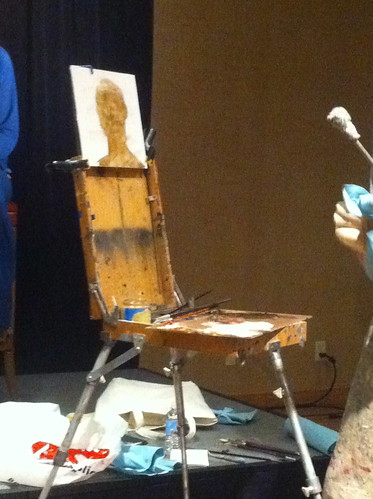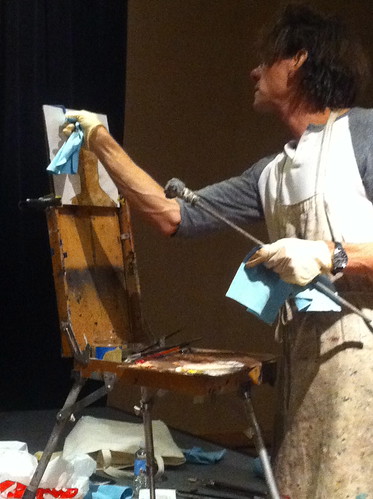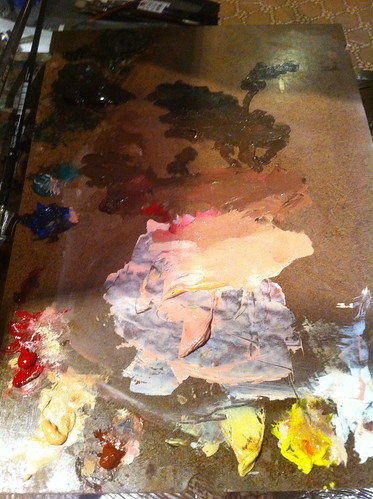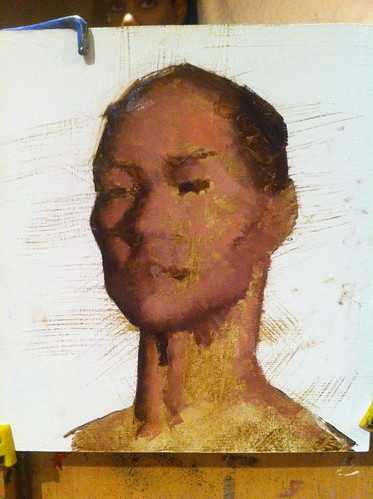Weekend with the Masters - Daniel Sprick Demo
On the last day of the Weekend with the Masters, hosted by American Artist Magazine, I took a one day workshop with an artist I have admired for years, Daniel Sprick.
The painting conference was structured so that students could take several one-day courses, choosing one instructor for each day (look to my two previous blog posts for other instructors courses I attended). All twenty instructors were master painters on the Realist fine art scene; quite an impressive roster with a wide span of approaches and philosophies ranging from the alla prima direct painters, to the Rembrandt school of thought, to the Classical Realists of the East Coast atelier scene to the many noted plein air painters of the West coast.
I was surprised and delighted when I saw Daniel Sprick's name on the roster since I had never before seen offerings of workshops taught by him in the past; this was a rare treat to meet the artist I have admired for so long. I was not disappointed.
An excerpt from an article written about him on his website:
"A Vermeer-like glow infuses many of Daniel Sprick’s paintings, often falling on objects from some unseen source. It spreads arbitrarily through his interiors, picking out this tangerine and that bottle, causing their color and form to bloom, submerging other parts of the painting in warm shadow. From Vermeer too, comes the suggestion of worlds within worlds. Oriental rugs imply distant exotic places (and perhaps Sprick’s obsession with flying via magic carpet as well). Paintings and fine art prints tacked to walls, tantalizing reflections in a blank television screen, figures half-seen through distant doorways enhance the notion of time and distance. Daniel Sprick also revisits the tradition of the still life as memento mori. Yet again, in these contemporary works, the traditional images of decay and dissolution –faded flowers, broken china, eggshells, a human skull---are leavened with humorous elements such as nibbled cookies and a seeping stain that spreads from a paper bag to the book it stands on. "
-- Jane Fudge
Jane Fudge is assistant curator of modern and contemporary art at the Denver Art Museum, and a visual art and film critic.
Daniel Sprick, "Passage", 36x30, oil on board
The painting conference was structured so that students could take several one-day courses, choosing one instructor for each day (look to my two previous blog posts for other instructors courses I attended). All twenty instructors were master painters on the Realist fine art scene; quite an impressive roster with a wide span of approaches and philosophies ranging from the alla prima direct painters, to the Rembrandt school of thought, to the Classical Realists of the East Coast atelier scene to the many noted plein air painters of the West coast.
I was surprised and delighted when I saw Daniel Sprick's name on the roster since I had never before seen offerings of workshops taught by him in the past; this was a rare treat to meet the artist I have admired for so long. I was not disappointed.
An excerpt from an article written about him on his website:
"A Vermeer-like glow infuses many of Daniel Sprick’s paintings, often falling on objects from some unseen source. It spreads arbitrarily through his interiors, picking out this tangerine and that bottle, causing their color and form to bloom, submerging other parts of the painting in warm shadow. From Vermeer too, comes the suggestion of worlds within worlds. Oriental rugs imply distant exotic places (and perhaps Sprick’s obsession with flying via magic carpet as well). Paintings and fine art prints tacked to walls, tantalizing reflections in a blank television screen, figures half-seen through distant doorways enhance the notion of time and distance. Daniel Sprick also revisits the tradition of the still life as memento mori. Yet again, in these contemporary works, the traditional images of decay and dissolution –faded flowers, broken china, eggshells, a human skull---are leavened with humorous elements such as nibbled cookies and a seeping stain that spreads from a paper bag to the book it stands on. "
-- Jane Fudge
Jane Fudge is assistant curator of modern and contemporary art at the Denver Art Museum, and a visual art and film critic.
Daniel Sprick, "Passage", 36x30, oil on board
Two interviews, the first from the Denver Art Museum, and the second, below, an excerpt from American Painting Video Magazine:
**************
Because
the conference was expensive to attend, I appreciated Sprick's
thoughtful note on the supply list that mentioned that we could use
whatever supplies we already had. He provided a list of his specific
materials also, and indicated that we were welcome to use those if we
chose but that it was not necessary.**
His supply list can be found here.
His supply list can be found here.
However, for this demo, Sprick was using Royal Talens water based oils that were provided as samples from a representative from Royal Talens/Canson at the conference. He used them all weekend in order to test them out, and seemed to like the results.
Sprick explained his process for preparing panels at home, which are Masonite panels primed with golden sandable gesso. The medium he uses with his oils is Liquin.
Sprick explained his process for preparing panels at home, which are Masonite panels primed with golden sandable gesso. The medium he uses with his oils is Liquin.
He began by drawing out an accurate silhouette of the head using angular lines rather than curves. After he figured out the height, width, and overall shape, he then filled in the shape of the head with a thin wash of a warm sienna-like tone. This under painting technique is called a grisaille or dead layer, which many artists use as a base for subsequent paint layers.
He intentionally left the area around the head white
since he has been creating a lot of figurative works in his studio with a white background as a
compositional element. Sprick's aesthetic for
portraits and figures often employs stark white backgrounds foiled against a fully
painted realistic portrait or full figure. He explained some of his
influences in this direction, referring to a Renaissance painter, who's
name I unfortunately did not catch, that also played with this idea. Additionally, contemporary print media often make use of photographed figures photoshopped against a white
background, a visual motif surrounding us today.
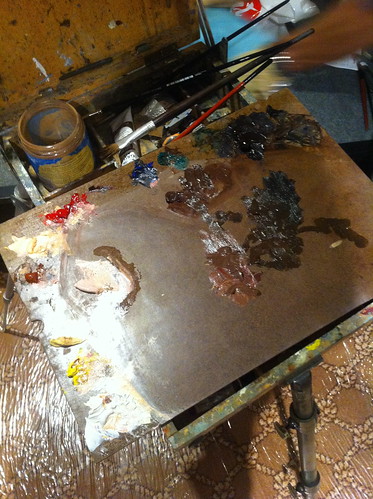
After he finished the flat, wash of the silhoutte, he began to paint on top of the grisaille, filling in the shadow areas as one connected shape all over the head (below) with a thicker consistency of paint.
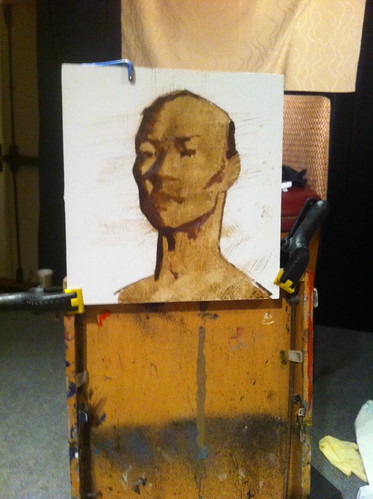
Sprick then mixed up the colors of the light in big piles from which he also used as a base for mixing middle tones.
At this stage, he began to lay the paint on thicker and in a "dabbing" manner instead of blending brush strokes together, carefully modeling the forms of the light.
He continued in this manner, slowly building up the light, mid tones, and adding further shape to the darker values.
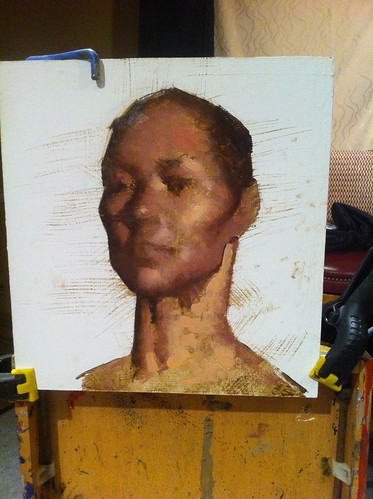
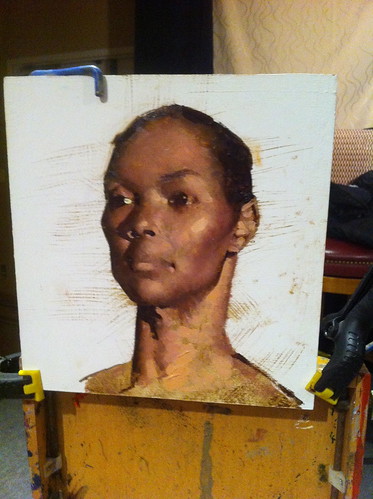
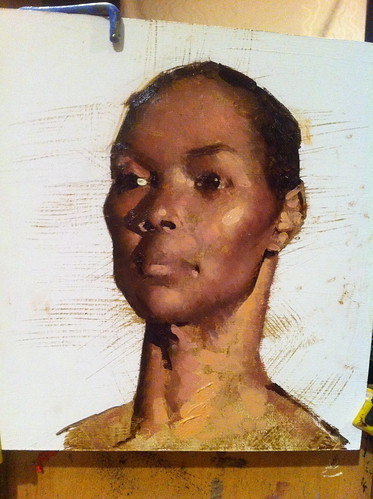
The finished demo, Daniel Sprick, 2011
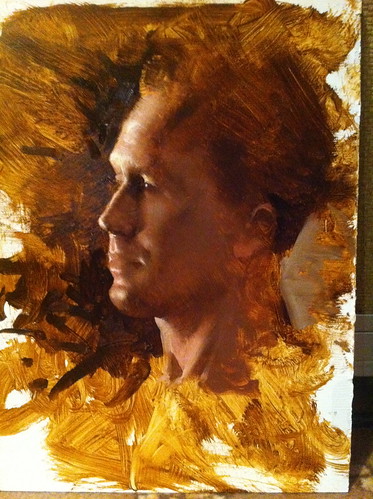
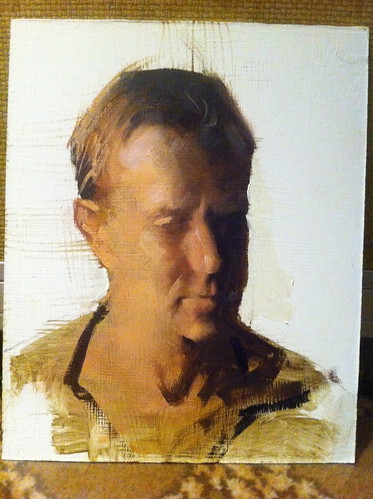
During the break at lunch time and before we painted from the model, Sprick showed us a slide show of his STUNNING portrait work on his ipad. He also talked about his interests in lighting for his still life paintings, using unusual sources of light including hot, artificial spotlights (on occasion) and interesting bounce light effects, like mirrors with blue gel on top, which bounces back into the set up. He also glazes areas of his paintings after they are completed if he finds the composition is not working the way he prefers, using the glazes to either push back or pull forward specific elements of his still life.
It was truly a joy to be in the same room with Daniel Sprick, talk with him and paint. I will not soon forget the experience!

It wasn't until this stage that he added the sharpest, darkest values and the lightest lights.
After he added these accents, it seemed to be a matter of adding a few very small accents in the highest range of the light in order to shore up the accuracy of the portrait.

It may look as though there are a lot of meticulous brush strokes on
this portrait, however up close I noticed the painting was far more
economical than I'd realized. Sprick has such command of the figure that
he is able to make incredibly exacting choices.

The finished demo, Daniel Sprick, 2011
Below are two additional demonstrations he painted from other sessions:


During the break at lunch time and before we painted from the model, Sprick showed us a slide show of his STUNNING portrait work on his ipad. He also talked about his interests in lighting for his still life paintings, using unusual sources of light including hot, artificial spotlights (on occasion) and interesting bounce light effects, like mirrors with blue gel on top, which bounces back into the set up. He also glazes areas of his paintings after they are completed if he finds the composition is not working the way he prefers, using the glazes to either push back or pull forward specific elements of his still life.
It was truly a joy to be in the same room with Daniel Sprick, talk with him and paint. I will not soon forget the experience!
** The Weekend with the Masters was quite expensive (for me), considering the cost
of the course, $1200, the fee for the hotel (I shared a room which came
to about $500), PLUS additional supplies for each chosen instructor and dining
fees. Thankfully I traveled by car, saving on air fare and cutting the
cost. I suggest to the hosts at America Artist Magazine to increase the attendance among the student population, that they include a discounted student rate much like the CTN Expo does for the Animation industry students.


